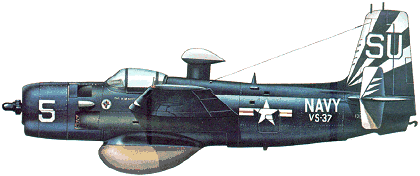Top speed 510 km/h Wingspan 18 m Weight 6,613 kg Manufacturer Grumman | Range 2,415 km Length 13 m First flight December 19, 1945 | |
Grumman af guardian
The Grumman AF Guardian was the first purpose-built anti-submarine warfare (ASW) carrier-based aircraft to enter service with the United States Navy. It consisted of two airframes, one for detection gear, the other for weapons. The Guardian remained in service until August 1955, when it was replaced by the twin-engined Grumman S-2 Tracker. The Guardian was the largest single-engine piston-powered carrier aircraft ever to see service.
Contents
- Grumman af guardian
- Design and development
- Operational history
- Variants
- Operators
- Survivors
- Specifications AF 2S Guardian
- References
Design and development

The original design concept for the aircraft that would become the Guardian, the XTB2F of 1944, was for a twin-engined aircraft with a 3,600 lb (1,633 kg) warload and a range of 3,700 mi (5,950 km). This was considered to be too large for practical use from an Essex class aircraft carrier, and was cancelled in 1945, replaced by a modified Grumman F7F Tigercat, the XTSF-1.

However, this too was considered impractical, and another alternative, the internally developed Grumman Model G-70, was selected instead, being given the Navy designation XTB3F-1. This was designed as mixed-power aircraft, with a Pratt & Whitney Double Wasp radial engine in the nose and a Westinghouse 19XB turbojet in the tail. This was found to be unsuitable, and the jet engine was removed without ever having been used in flight. The XTB3F-1S carried a crew of two seated side-by-side and an armament of two 20 mm cannon and 4,000 lb (1,814 kg) of bombs, torpedoes and/or rockets, and made its first flight on 19 December 1945.

On 24 December 1945, the Navy changed the role of the aircraft from torpedo-bomber to anti-submarine warfare. All the required equipment could not be fitted into a single aircraft, consequently two variants would be produced, one as a "guppy" (hunter) and another as a "scrapper" (killer). The hunter aircraft would not carry any armament, but instead two additional crew members and a ventral radome for APS-20 search "eyes" (radar) and Electronic Countermeasures (ECM) "ears", consisting of an APR-98 Countermeasures Receiver and AP-70 Bearing Indicator. This aircraft, the XTB3F-1S, first flew in November 1948. The "killer" deleted the cannon of the torpedo bomber, but retained the bomb bay, added a third crewmember, a searchlight, and short-range radar, and (as the XTB3F-2S) first flew in January 1949.
Operational history

Redesignated as AF-2W (TB3F-1S) and AF-2S (TB3F-2S), the Guardian entered fleet service on 27 September 1950 with three aircraft delivered to VS-24, with full service introduction shortly after with VS-25. A total of 193 AF-2S Guardians were built. In 1952, the AF-3S (hunter) was introduced, fitting a magnetic anomaly detector (MAD) for the detection of submerged submarines; 40 of this variant were built. The last Guardian was delivered to the Navy in March 1953, with a total of 389 built.
The Guardian saw service in the maritime patrol role during the Korean War, however it proved unpopular with pilots, being underpowered and heavy on the controls; the aircraft suffered from a severely high accident rate. Shortly after the end of the war, it began to be replaced by the Grumman S2F Tracker, the U.S. Navy first purpose-built ASW airplane to combine the hunter and killer roles in a single airframe. The last AF retired from active service on 31 August 1955, but it remained in service with the US Naval Air Reserve until 1957.
Variants
Operators
Survivors
After disposal by the U.S. Navy five Guardians saw many years service with Aero Union based at Chico, California, in the forest firefighting role, the last being retired in 1978.
None.
Specifications (AF-2S Guardian)
Data from United States Navy Aircraft since 1911.
General characteristics
Performance
Armament
